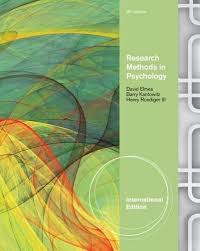Description
Research Methods in Psychology International 9Th Edition By David G. Elmes
CHAPTER 5
OBSERVATIONS IN PSYCHOLOGICAL RESEARCH
Synopsis
The main goal of the chapter is to provide an overview of the observational procedures that are used in psychology. The chapter focuses on descriptive research: naturalistic observation, case studies, surveys, and meta-analysis. The modes of observation are discussed in detail here because they receive little attention elsewhere in the book. After outlining some of the advantages associated with descriptive research, we discuss problems arising from researcher bias and participant reactivity.
Outline
DESCRIPTIVE OBSERVATION METHODS
Naturalistic Observations
The Case Study
Survey Research
ADVANTAGES OF DESCRIPTIVE OBSERVATIONS
SOURCES OF ERROR IN DESCRIPTIVE RESEARCH
APPLICATION: Difficulties of Observation
REACTIVITY IN DESCRIPTIVE RESEARCH
Naturalistic Observation
Case Studies
Surveys, Interviews, and Tests
SUMMARY
KEY CONCEPTS
EXERCISES
SUGGESTED RESOURCES
WEB RESOURCES
LABORATORY RESOURCE
PSYCHOLOGY IN ACTION: Remembering the 9/11 Terrorist Attacks
New to This Edition
• Chapter Organization: This chapter was Chapter 4 in the previous edition.
• Updated Examples: A new figure (Figure 5-2) has been added as a sample ethogram. A brief discussion on dolphin communication has been added to the section on ethograms. The work of Brazleton on infant development has been expanded and brought up-to-date. New work on the effects of PCBs on development is discussed in the section on testing neonates. Finally, Neisser & Hyman (1981) has been updated to Neisser & Hyman (2000).
• Updated & Additional References: The reference to Oltmanns, Neale, & Davison (1999) has been deleted and replaced with the updated reference of Oltmanns, Neale, & Davison (2006) in the section on case studies. Orzech (2005) was added as the reference for the new Figure 5-2.
Information on the Dolphin Communication Project (2009) was added to the section on ethograms. Brazleton & Nugent (1995) and Sagiv, et al. (2008) were added as references on the section on neonates to expand and make the information more up-to-date.
Definitions of Key Concepts
Anthropomorphizing is the attribution of human characteristics to a non-human animal.
A case study is a detailed examination of the behavior of one individual (or, alternatively, a small number of individuals).
Demand characteristics are the various pressures that are exerted on participants by the researcher (e.g., expectation of obedience); the term is an older, more specific term for reactivity.
Descriptive observations are observations of the type, quantity, and frequency of particular behaviors, and do not try to provide causal explanations of those behaviors.
A deviant-case analysis compares two similar cases that differ in outcome in the hopes of fostering inferences about the cause(s) of behavior.
A behavior’s ecological function is how the behavior helps the organism adapt to the environment.
Ecological validity refers to the degree to which the research setting reflects the critical characteristics of the corresponding situation in the real world, which will impact whether or not research results can effectively be argued to generalize.
An ethogram is an inventory of behaviors performed by one species of animal.
Ethology is the study of naturally occurring behavior, which often takes place in the wild.
In a forced-choice test the observer must answer a given question by choosing between some fixed numbers of alternatives. In survey research these tests can be used to minimize reactivity by equating the choices in terms of social desirability.
Interobserver reliability refers to the degree of consistency in the categorization of behavior

Reviews
There are no reviews yet.